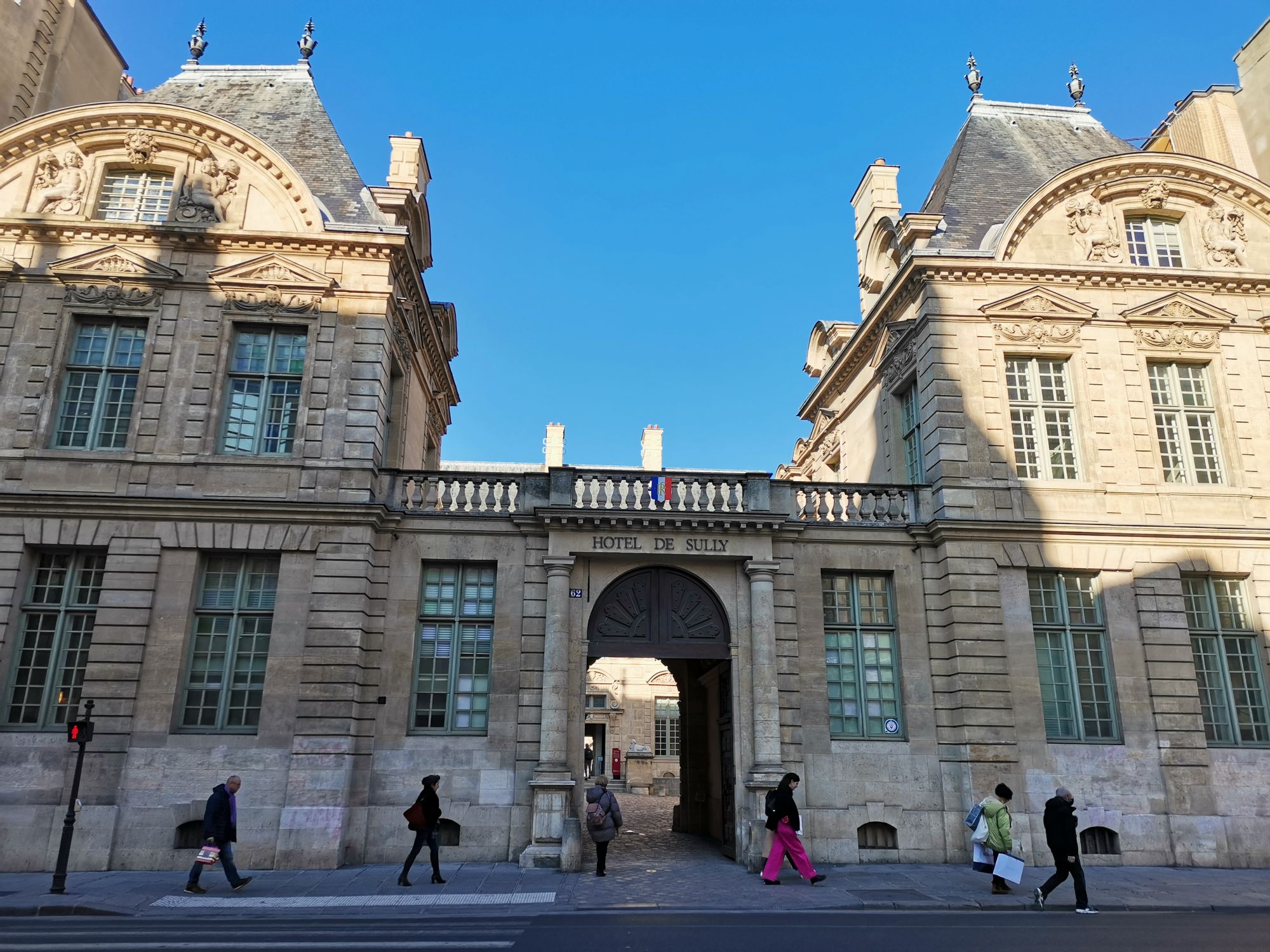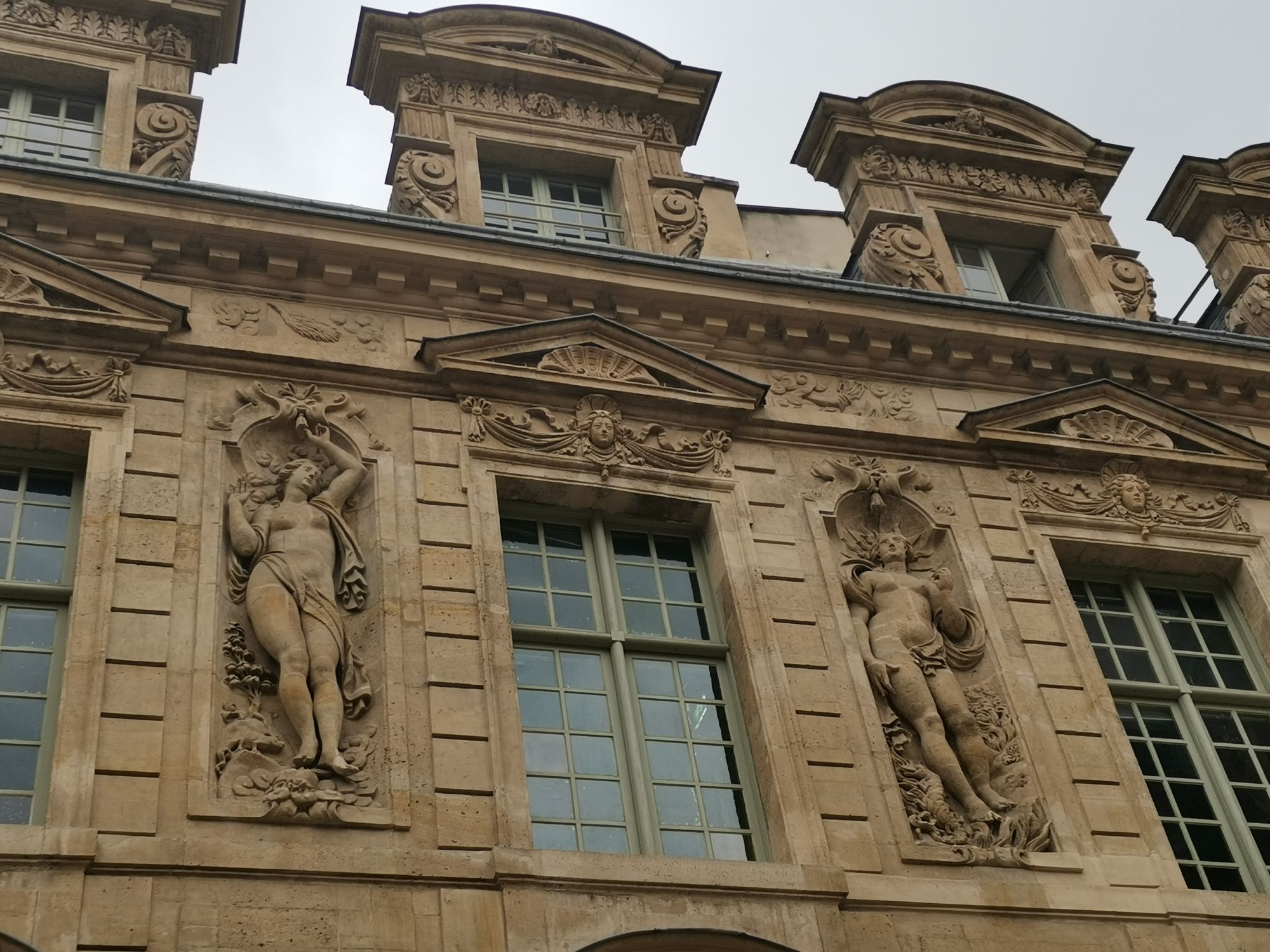The Hôtel de Sully
Discover our guided tours of the marsh
About the Hôtel de Sully, one of the marsh's architectural gems
Where is the Hôtel de Sully? How to get to the Hôtel de Sully
When did construction of the Hôtel de Sully begin?
Description of the Hôtel de Sully
Why was the Hôtel de Sully built?
Who were the architects of the Hôtel de Sully? who commissioned it?
Who is the current owner of the Hôtel de Sully today and its current use?
Is the Hôtel de Sully part of our guided tours?
Where is the Hôtel de Sully? How do I get to the Hôtel de Sully?
 The Hôtel de Sully is located at 62, rue Saint-Antoine.
The Hôtel de Sully is located at 62, rue Saint-Antoine. Access
Metro: Saint-Paul (line 1)
Bus: 69, 76 or 96, Saint-Paul stop. Or bus: 69, 76, Birague stop.
What's special is that you can also get there via Place des Vosges, crossing the garden and courtyard. This route can be taken in either direction every day from 9am to 7pm.
Please note that the interiors are closed to the public except for special tours (see the Centre des monuments nationaux website).
When did construction of the Hôtel de Sully begin?
 In 1624, during the reign of Louis XIII, Mesme Galet, Comptroller of Finances, bought the Baillet house. In 1625, he commissioned master mason Jean Notin to build a mansion, probably based on designs by Jean 1er Androuet du Cerceau. The plot, which opened onto rue Saint-Antoine with two medieval dwellings, adjoined the Place Royale (now Place des Vosges) via a garden at the back of which was to be an orangery. In 1627, Galet was forced to resell his unfinished house, which in 1628 passed to Roland de Neubourg, Seigneur de Sarcelles. He had the wings completed and the street façade built. In 1634, Maximilien de Béthune, Duc de Sully, aged 74, bought the mansion. He commissioned the interior decoration. His grandson had the left wing converted in 1651 by the architect François le Vau. Finally, in 1660, the third duke built the right wing overlooking the garden.
In 1624, during the reign of Louis XIII, Mesme Galet, Comptroller of Finances, bought the Baillet house. In 1625, he commissioned master mason Jean Notin to build a mansion, probably based on designs by Jean 1er Androuet du Cerceau. The plot, which opened onto rue Saint-Antoine with two medieval dwellings, adjoined the Place Royale (now Place des Vosges) via a garden at the back of which was to be an orangery. In 1627, Galet was forced to resell his unfinished house, which in 1628 passed to Roland de Neubourg, Seigneur de Sarcelles. He had the wings completed and the street façade built. In 1634, Maximilien de Béthune, Duc de Sully, aged 74, bought the mansion. He commissioned the interior decoration. His grandson had the left wing converted in 1651 by the architect François le Vau. Finally, in 1660, the third duke built the right wing overlooking the garden.Description of the Hôtel de Sully
Like most Parisian private mansions, the Hôtel de Sully features a main building set between a courtyard and a garden, protected by a street façade and a portal. The street façade is flanked by two large pavilions whose rounded pediments are decorated with small, full-figured loves holding helmets. Between these two pavilions is the portal, framed by columns and topped by a terrace with balustrades - an arrangement restored during the restoration.
The courtyard is surrounded on three sides by powerful main buildings of equal height. The facades are decorated in a mannerist, sculpted style. Originally, the hotel was to have been built in brick and stone, like the Place Royale, but Mesme Galet opted for an all-stone construction so as to be able to carve a rich décor: pediments, mascarons, shells and linens. On the wings, niches house bas-relief figures representing the Four Elements: on the left, Air and Fire, on the right, Water and Earth. The main body, on the other hand, is adorned with two Seasons: Autumn and Winter, represented by Bacchus and an old man draped in cold clothes. Access to the main building is via a bridge guarded by two sphinxes.
In the center of the residence, which it bisects, rises the grand central staircase with its “Italian-style” scaffold wall, all in stone. It serves as a passageway to the garden.
On the garden side of the façade, the two other seasons are represented by Flora and Ceres: Spring and Summer. A terrace, in keeping with the fashion of the time, overlooks the garden. It is bordered, on the right, by the original feinted arcades, and, on the left, by the wing built in 1661, which harmoniously reproduces the Louis XIII façade.
The garden features four lawn parterres. At the far end stands the elegant little orangery building, framed by two pavilions built as early as 1624 and erroneously referred to as “Petit-Sully”. The pavilion on the right leads to the Place des Vosges.
The hotel's interiors have preserved several rooms adorned with beamed ceilings and painted joists: on the first floor, the study of Sully's wife and the great hall, converted into a bookshop in 1993, and, on the first floor, small study rooms.
Of the apartment built in 1661 in the Pavillon neuf overlooking the garden for the third Duchesse de Sully, we still have the antechamber with its geometrically painted ceiling, a small study with its allegorical ceiling and, above all, the great room. The latter is decorated with white and gold wainscoting and covered with a skullcap ceiling featuring Antoine Paillet's L'Enlèvement d'Endymion. The alcove, also with its painted ceiling, has been preserved, as has the oratory, which has no windows.
Why was the Hôtel de Sully built?
For a member of the financial elite like Mesme Galet, it was a symbol of personal success, as it was for the aristocrat Maximilien de Béthune, Duc de Sully. It's all about appearances. In the case of the Sully family, there was also a desire to pass on this heritage from generation to generation. The Marais was a fashionable district, close to King Louis XIII. In his salons, the Duc de Sully entertained literati such as Voltaire and Mme de Sévigné.
In the 19th century, the hotel became more humble, becoming home to a boarding school for girls in 1827, where Auguste Blanqui taught for a time. In 1909, the Société des amis des monuments des arts rented part of the left wing, and its president, Charles Normand, founded a small “Musée du Vieux Paris”.
The hotel was then entirely rented out, the garden covered by a workshop and the orangery, which had been detached from the estate since 1859. Shops could be seen there. In the mid-twentieth century, the hotel was bought by the State, which restored it and installed the headquarters of the Centre des monuments nationaux.
Who were the architects of the Hôtel de Sully and who commissioned it?
The first plans for the hotel were drawn up by Jean 1er Androuet du Cerceau (1585-1649), chosen by Mesme Galet in 1625. He was King Louis XIII's ordinary architect, a contractor on the Rouen bridge, and took part in the following works: the horseshoe staircase at Fontainebleau in 1623, the Hôtel de Bretonvilliers (now no longer standing, on the Île Saint-Louis), and the Pont au Change. He was the grandson of Jacques 1er, a renowned French architect, theorist and engraver. Mesme Galet was comptroller of King Louis XIII's finances, and his love of gambling ruined him and forced him to sell.
Roland de Neubourg, Seigneur de Sarcelles, bought the unfinished house in 1628. He had the wings completed and the street façade built. In 1634, his son-in-law sold the property to Maximilien de Béthune, Duc de Sully, who gave his name to the hotel. He was 74 years old at the time. Sully was a former minister and confidant of Henri IV, and his family kept the hotel until 1752. He commissioned the interior decoration and lived there in part until his death in 1641.
In 1651, his grandson, the second Duc de Sully, commissioned the architect François le Vau (1613-1676) to transform the gallery in the left courtyard wing into an apartment, of which only a few remains today. He came from a renowned architectural family: his father Louis Le Vau (1580-1661) was architect and inspector of royal buildings, and his brother, Louis Le Vau, was first architect to King Louis XIV and first architect of the Château de Versailles. His works include several residences and private mansions in and around Paris. He also designed the church of Saint-Louis-en-l'Ile.
In 1660, the third Duc de Sully commissioned architect and contractor Simon Lambert to build the right wing overlooking the garden.
The mansion remained in the Béthune-Sully family until 1752, when it was sold to the Turgot de Saint-Clair family, allied to Louis XVI's famous minister.
Who is the current owner of the Hôtel de Sully and what is its current use?
The hotel was acquired by the French state in 1944, and the orangery in 1952. It was fully restored in 1950-1970 and returned to its former glory. Since 1967, it has housed the headquarters of the Caisse Nationale des Monuments Historiques et des Sites, which became the Centre des Monuments Nationaux in 2000.
The interiors of the Hôtel de Sully can be visited in an exceptional way, and are home to a bookshop selling works of art, including those produced by the Cmn under the Éditions du patrimoine label. The Hôtel de Béthune-Sully joined the Marais Culture + network inaugurated in June 2014 comprising more than 20 cultural institutions in the district with the aim of “actively promoting, animating and preserving the preciously conserved treasures of this part of old Paris”.
Is the Hôtel de Sully on any of our guided tours?
Yes, some of our tours include the interior courtyards of this magnificent Hôtel de Sully.
Page written by Chloé Depras
Photo credits: Claire Cornic
Back to summary of the Hôtels particuliers du Marais